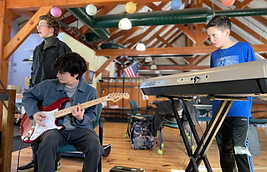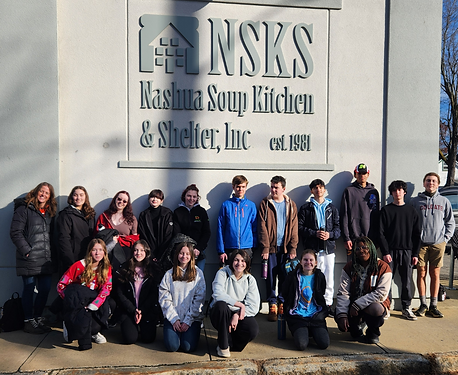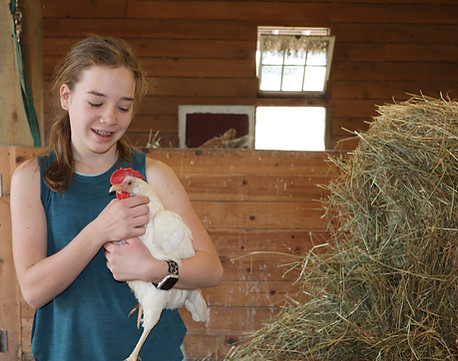
MATHEMATICS
SNA MATH MANTRA
+ Math is meaningful
+ Mindset matters
+ All students can be successful in math
+ There can be multiple ways to solve a problem
An Introduction
While math can feel “big,” it should always be approachable. Math should be hands-on, collaborative, and explorative. After all, it is everywhere we look in the natural world and its real-world applications are far more innumerable and tangible than we often give the subject credit for. 2nd Nature Academy strives to break down the barriers that have been erected in the minds of too many learners, instead encouraging all students to approach math with open minds, teaching them how to think critically, and challenging them to make connections across disciplines, as well as the world at large. It is our goal to instill in all learners an enthusiasm for math, to develop growth mindsets, and establish positive math class norms. Moreover, we encourage all parents/guardians to consider the critical role they play in their child’s mindset and achievement in math.

Elementary School
Program:
Think Math!
Think Math! builds on children’s innate desire to make sense of the world through the implementation of puzzles, investigations, and games. Beyond skill development, learners are provided the tools to build strong mathematical habits of mind. With a basis in developmental psycholinguistics and child language, cognitive science, child development, and math teaching/learning research, this program was rigorously tested in classrooms and is supported by the National Science Foundation.

Middle School
Program:
Core Curriculum by MidSchool Math
Research has shown that this multidimensional, growth mindset curriculum provides a much more enriching math experience and results in deeper student engagement, excitement, and success. It teaches students to think like mathematicians through providing opportunities for developing confidence and solving rigorous challenges. A healthy dose of humor goes a long way in appealing to middle school audiences. Our middle school math teacher is trained in Stanford Math Professor and program co-designer Jo Boaler’s Mathematical Mindsets approach. Professor Boaler is an advocate for bringing about higher levels of student engagement and achievement in mathematics. To learn more about the program, we invite you to read this Letter to Parents and Guardians from MidSchoolMath.

High School
Disciplines taught:
-
Algebra I & II
-
Financial Literacy
-
Geometry
-
Trigonometry
-
Pre-Calculus
-
Calculus
Through a PBL approach, students will organically embrace learning techniques that respond to their desire to explore the mathematical world around them. This, in turn, enables students to ask questions, engage in multidimensional activities, and explore real-world scenarios with authentic curiosity. Each lesson/unit follows a five phase process:
-
Immersive Experience
-
Student Discussion
-
Teacher-Directed Lesson
-
Skill Practice
-
Ongoing Project

HUMANITIES
At 2nd Nature Academy (SNA), humanities education is a key component of our integrated, inquiry-based, and student-centered learning model. Many academic subjects fall into this category, namely English language arts, history, and social studies.
K-5
During the elementary years, SNA focuses on developing foundational literacy (reading and writing) skills through multi-sensory and integrated activities. Students are encouraged to explore language through storytelling, phonemic awareness, and interactive reading experiences, fostering a love for reading and writing from a young age. Through inquiry and problem-based learning, students are encouraged to explore historical events, cultural traditions, and societal structures. Our curriculum integrates storytelling and literature to foster empathy and understanding of diverse perspectives, aligning with SNA's focus on social-emotional wellness and community connections.
As students progress into middle school, they are encouraged to delve deeper into literary analysis, exploring themes, character development, and author's purpose across a range of genres. Writing instruction focuses on enhancing students' abilities to construct well-organized arguments, narratives, and informational texts, with attention to grammar, syntax, and style. Students also benefit from a flexible curriculum that supports active and personalized learning, involving deeper exploration of history, geography, and cultural studies. This encourages students to analyze complex social issues and historical contexts. Teachers emphasize cooperative learning and community outreach, allowing students to engage in projects that connect classroom learning to real-world scenarios. The integration of these skills with other disciplines supports the development of interdisciplinary thinking and real-world application of language skills.
6-8
9-12
At the high school level, students are expected to engage with diverse and complex texts, as well as produce sophisticated written work across subjects. The curriculum aims to prepare students for college-level reading and writing, as well as effective communication in diverse contexts. SNA's approach transcends traditional subject boundaries and students are challenged to undertake real-world problems and projects, applying skills and knowledge from multiple disciplines. This approach fosters critical thinking, effective communication, and a deeper understanding of human experiences across time and cultures.
Core Humanities Principles at SNA
-
Inquiry-Driven Learning: encouraging students to ask questions and explore human societies and cultures
-
Integrated Curriculum: connecting humanities with other disciplines to provide a holistic understanding of complex issues
-
Community Engagement: promoting active participation in community projects to apply humanities concepts in real-life contexts
-
Critical Thinking: developing the ability to analyze, evaluate, and synthesize information
-
Cultural Appreciation: fostering respect and understanding for diverse cultures and perspectives
Through this comprehensive approach, SNA's humanities program aims to cultivate informed, empathetic, and engaged citizens within their societies.

SCIENCES
At 2nd Nature Academy (SNA), science education is rooted in curiosity, exploration, and authentic scientific practice. Aligned with the school’s inquiry-based, interdisciplinary philosophy, science is taught not just as a subject, but as a process of understanding the world. Students engage in investigations that mirror the work of real scientists, building a strong foundation in scientific thinking, problem solving, and environmental stewardship. Annual school-wide themes (modeled after high school-level concepts) serve as guiding frameworks for elementary and middle grade science studies, allowing students to explore age-appropriate content that connects to broader global issues such as sustainability, human impact, or systems thinking.
K-5
In the Lower School, science is experienced through hands-on discovery and observation of the natural world. Students are introduced to the scientific method as a way to ask questions, form hypotheses, gather data, and communicate findings. Science is woven into broader interdisciplinary projects and tied to real-world themes, ensuring a dynamic and meaningful experience.
Middle school science continues to build on the core tenets of the scientific method, emphasizing student-designed experiments, critical thinking, and collaborative inquiry. Students operate like scientists—identifying problems, collecting and analyzing data, presenting findings, and refining their conclusions. Annual themes continue to guide learning across disciplines, helping students explore complex scientific topics through a variety of lenses, including environmental science, physics, biology, and earth systems. This approach fosters deep understanding and prepares students for more specialized study.
6-8
9-12
Science education at the high school level is interdisciplinary, college-preparatory, and grounded in authentic inquiry. Students apply the scientific method to advanced investigations and real-world challenges, often in connection with community-based research or environmental projects.
High school students are expected to work independently and collaboratively, designing experiments, interpreting data, and communicating scientific conclusions in both written and oral formats. Course offerings are structured to meet and exceed college admissions requirements, ensuring students are well-prepared for higher education pathways in STEM and beyond.
Inquiry-Driven Learning:
Students are guided by curiosity, formulating their own questions and hypotheses.
The Scientific Method:
Used across all grade levels as the backbone of investigation and discovery.
Student-as-Scientist Mindset:
Learners take on the role of scientists, engaging in authentic processes of experimentation, analysis, and reflection.
Annual Thematic Integration:
School-wide themes connect scientific study to real-world and interdisciplinary contexts.
Environmental Connection:
Learning extends beyond the classroom into nature and the local community.
College and Career Readiness:
Curriculum pathways meet college application criteria and foster lifelong scientific literacy.
With a focus on inquiry, integration, and impact, SNA’s science program inspires students to think critically, act ethically, and contribute meaningfully to scientific and environmental communities.
Core Sciences Principles at SNA

FOREIGN LANGUAGES

español
Spanish

汉语
Mandarin
SPANISH & MANDARIN
The 2nd Nature Academy foreign language curriculum includes both Spanish and Mandarin Chinese, beginning in pre-kindergarten. Mandarin claims the top spot as the world’s most commonly spoken language, followed by Spanish and then English. By teaching both Mandarin and Spanish we are preparing our children for a global economy. We are training our students to become cross-culturally competent adults who will be successful in handling the challenges that globalization can present. Finally, students who are culturally and linguistically prepared to effectively communicate both abroad and in a pluralistic American society have greater changes for success.
THE IMPACT
Studies indicate that there are many cognitive benefits to learning a foreign language. In addition to impacting student’s linguistic abilities, second language learning has been shown to increase creative abilities as well. Furthermore, the younger children are when they begin to learn a foreign language, the greater the impact. If children begin learning a foreign language in early childhood, they will exhibit greater intellectual benefits over those children who do not learn a foreign language or begin learning later. Typically, American schools do not begin teaching foreign languages until middle school, when children have passed the critical period for language acquisition.
The National Standards for Foreign Language Education in the 21st Century encompass the five C’s of essential foreign language education:
-
Communication
-
Culture
-
Connections
-
Comparisons
-
Community
The foreign language curriculum at 2nd Nature Academy embraces a wide range of communication skills recommended by the American Council for Teaching Foreign Languages. These standards provide a vision of what students should know and be able to do with other languages. In order to attain these standards, we provide a foreign language program that provides rich curricular experiences in order to develop positive attitudes and excitement toward learning foreign languages.
STUDENT FOREIGN LANGUAGE SPEAKERS IN ACTION


Welcome, Ziyu Li!

Por cuatro esquinitas de nada (Four Little Corners) by Jérôme Ruillier

THE ARTS
VISUAL ARTS
At 2nd Nature Academy, we believe in art’s power to provide students with an alternative language with which to communicate, create meaning, and express themselves in a safe space where open minds are free to wander.
Visual arts education at 2nd Nature Academy encourages self-expression, inspires creativity, builds confidence, and helps develops a sense of individual identity in each student. By incorporating inspirational art stimuli, students are engaged by and exposed to the design, color, form, rhythm, texture, and pattern in the world around them. Through learning the essential skills to be successful in this new age, students are provided developmentally-appropriate instruction on art techniques, materials, and history. Exposure and experience with arts allows students to create, design, generate, and compose new ideas, further developing the creative thinking inherent in developing minds, which is at the core of a 2nd Nature Academy education. Moreover, creating meaning through art can help children develop vocabulary, complex thinking, and keen observation, as well as hone innovative problem-solving skills.
STUDENT WORK GALLERY

MUSIC EDUCATION
Music is a very powerful thing. It brings people together. It educates. And it is a catalyst for growth. Music, like all art, is essential to any education.
Music education at 2nd Nature Academy promotes creativity, confidence, social skills, and artistic expression. Musical studies at SNA focus on learning a variety of modes of self-expression and identity exploration. As a community, we learn about a multitude of instruments, including hand percussion, drums, piano, ukuleles, and more. Musical education supports student development in the following areas, including but not limited to: critical thinking and listening, problem-solving, self and social confidence, artistic independence.
SNA ROCK BAND
The SNA Upper School Rock Band was founded in the fall of 2021 by a group of high school students. It has since grown to include students in both middle and high school. Band members practice weekly with the occasional appearance at school events, such as high school graduation.



COMMUNITY CONNECTIONS
SERVICE LEARNING
As part of our curriculum at 2nd Nature Academy, our school community participates in regular service learning projects. Service learning is a teaching and learning strategy that integrates meaningful community service with instruction and reflection to enrich learning experiences, engage children in civic involvement, promote responsibility, and strengthen communities. We encourage families to continue these valuable discussions at home.
Over the course of a school year, family support is enlisted to assist us in preparing for these projects by purchasing items together with your child, donating to various charities, or contributing time to help coordinate and/or participating in service experiences. In order for the children to gain from these experiences, they must learn to recognize the community need and know the intended recipient of the service. Moreover, it is critical that they have active participation in service experiences and are provided time for meaningful reflection. Together, we can form truly meaningful experiences for your child and your family, our staff, and the community.
Each year, the student body guides decision making about causes, events, and learning goals. Examples of past and continuing service learning traditions include:
-
Ann M. Francke Memorial Ride benefiting Friends of Dartmouth Cancer Center
-
Student-run hot dog sale with proceeds being used to select livestock donations to rural communities worldwide via Heifer International
-
Christmas gift drive for sponsored mothers and children at Marguerite's Place, Inc.
-
Water Walk to support Thank You Project's mission of building wells in rural Nigeria
-
Clothing and hygienic products drive to support Catie's Closet
-
Canned food drives to support the Nashua Soup Kitchen and Shelter
-
Valentine cards for American troops with A Million Thanks
-
Earth Day/Week spirit events coordinated by high school students to educate and encourage younger student population about environmental causes
-
Student produced "Portraits of Courage" (interviews with and artistic portraits of local veterans)
-
Student-driven "shoe cutting" party to produce denim shoes for SoleHope, which provides shoes for Ugandan people suffering from jiggers
-
Fundraiser for and guest speaker event from Jhamtse Gatsal Children's Community in Indian Himalayas

HUMANE EDUCATION
Our humane education curriculum is designed to instill respect and responsibility for fellow humans, animals, plants, and the environment. By nurturing compassion for living things, we develop conscientious, actively contributing members of society. Everything on our planet is interconnected and it is through our stewardship that we are able to be a part of that pattern.
Humans not only rely on one another, but also non-human animals and our natural environment for resources, food, service, and companionship. In return, it is our responsibility to care for each other, as well as providing the animals in our care with quality food and forage, access to clean water, medical care, shelter, room to roam, and companionship. It is likewise imperative that we understand the importance of caring for our environment, so that the next generations can enjoy it.
In addition, our humane education program encompasses:
-
Organic gardening
-
Environmental science
-
Sustainable farming & animal care
-
Service learning
-
Character education
-
Peer mentoring
-
Classroom jobs & school economy
-
Social justice education
-
Healthy, high-performance campus with green buildings
-
Critical thinking & problem-solving
-
Constructive classroom management






























